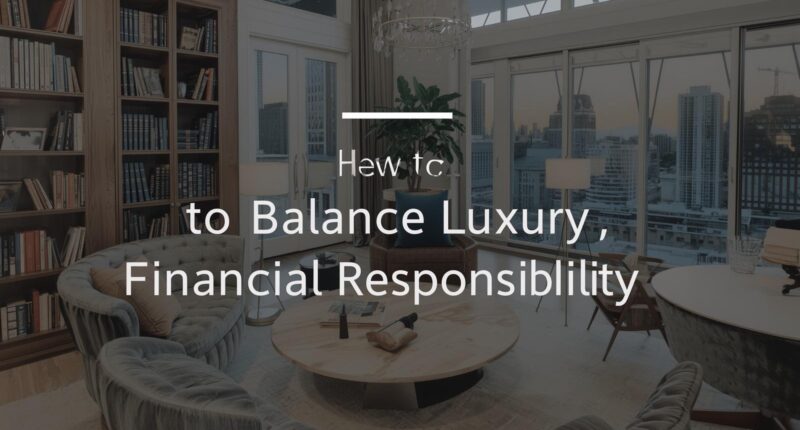How to Balance Luxury and Financial Responsibility
Introduction: Finding the Right Balance Between Luxury and Financial Stability
In today’s fast-paced world, balancing luxury and financial responsibility has become an essential life skill. Everyone dreams of enjoying the finer things in life — designer clothes, vacations, high-end gadgets — but without proper planning, these desires can lead to debt and financial stress.
The goal isn’t to give up luxury; it’s to enjoy it smartly. When managed wisely, you can live comfortably, experience occasional indulgence, and still build a strong financial future.
H2: Understanding the Meaning of Financial Responsibility
Financial responsibility means being aware of how you earn, spend, save, and invest your money. It’s about making smart choices that align with both your short-term desires and long-term goals.
Being financially responsible doesn’t mean cutting out luxury completely; it means knowing when, how, and why you spend on luxury items.
Key Traits of Financially Responsible People
-
They budget and track expenses regularly.
-
They prioritize needs over wants.
-
They save a portion of income before spending.
-
They understand the value of delayed gratification.
-
They invest in assets that generate long-term growth.
H2: Why Luxury Can Still Have a Place in a Responsible Budget
Luxury spending, when done wisely, can actually enhance your life satisfaction. It provides motivation, boosts confidence, and rewards hard work. The key is to maintain balance — spending without compromising your financial security.
Example: Smart Luxury Spending
You might decide to buy a designer handbag once a year — but only after saving for it intentionally rather than using credit cards impulsively. This mindset keeps your finances healthy while still allowing personal enjoyment.
H2: Table – Comparison Between Luxury Lifestyle and Responsible Living
| Aspect | Luxury Lifestyle Focus | Financial Responsibility Focus |
|---|---|---|
| Spending Pattern | High spending on wants | Controlled spending on needs first |
| Savings Rate | Low or inconsistent | Regular and disciplined |
| Investment Mindset | Enjoy now, worry later | Plan now, enjoy later |
| Emotional Outcome | Short-term satisfaction | Long-term peace and stability |
| Credit Usage | Often dependent on debt | Uses credit strategically and rarely |
As shown, luxury doesn’t have to disappear — it simply needs to be managed through responsible financial planning.
H2: Building a Budget That Allows for Luxury
The smartest approach to balancing luxury and responsibility is creating a budget that includes luxury spending. This means allocating a small percentage of your income specifically for lifestyle upgrades or personal rewards.
Steps to Create a Balanced Budget
-
Calculate your total income.
-
Assign fixed costs — rent, utilities, insurance, etc.
-
Set savings and investment goals.
-
Allocate a “luxury fund” (5–10% of your income).
-
Track and adjust monthly spending to stay within limits.
By giving yourself permission to enjoy small luxuries, you’re less likely to overspend impulsively.
H2: Prioritizing Long-Term Financial Goals
While luxury feels rewarding in the moment, long-term financial security provides peace of mind.
To maintain balance:
-
Build an emergency fund that covers 3–6 months of expenses.
-
Focus on retirement savings through long-term investments.
-
Pay down high-interest debt before making new luxury purchases.
-
Invest in self-growth and education — the most valuable luxury of all.
A person who plans for the future can afford luxury without stress later in life.
H2: Mindful Spending – The Secret to Sustainable Luxury
The modern approach to luxury and financial responsibility is mindful spending — knowing the emotional and practical reason behind every purchase.
Before buying something, ask yourself:
-
Does this purchase add lasting value to my life?
-
Can I afford it without touching my savings?
-
Will I regret not saving this money later?
This kind of intentional thinking helps avoid emotional overspending, one of the biggest threats to financial balance.
H2: Investing in Meaningful Luxury
Not all luxury is wasteful. Meaningful luxury can be experiences or assets that appreciate in value — such as:
-
Quality real estate or artwork
-
Travel that enriches your life
-
Courses or certifications that boost your career
-
Health and wellness investments
When you spend on meaningful luxury, you align pleasure with purpose.
H2: Internal and External Resources
To explore smart wealth strategies that support a luxurious yet balanced life, check out these resources:
Link: Learn more in our guide — Investing for Lifestyle Freedom: A Modern Approach — and discover how smart investments can help you live luxuriously without financial stress.
Link: Read expert insights on personal budgeting and money psychology at NerdWallet’s Financial Wellness Hub.
These resources will help you structure your lifestyle in a way that supports financial freedom and self-enjoyment.
H2: Common Mistakes When Trying to Balance Luxury and Responsibility
Many people fail to achieve balance because they:
-
Don’t track their luxury spending
-
Try to impress others instead of prioritizing personal goals
-
Use credit for temporary happiness
-
Neglect emergency savings
-
Forget that luxury can mean time, peace, and freedom, not just expensive goods
Avoiding these pitfalls ensures your lifestyle remains both elegant and sustainable.
Conclusion: Living Luxuriously and Financially Smart
Balancing luxury and financial responsibility isn’t about restriction — it’s about alignment. True wealth means living the life you want without financial stress.
You can drive the car you love, travel the world, or dine at fine restaurants — as long as those luxuries don’t compromise your savings, investments, or peace of mind.
In essence, luxury should empower your lifestyle, not endanger it.
When you master this balance, you achieve what many dream of — a financially free and fulfilling life.









